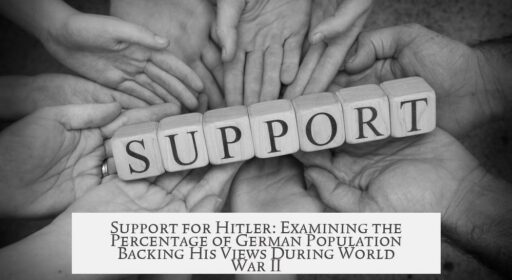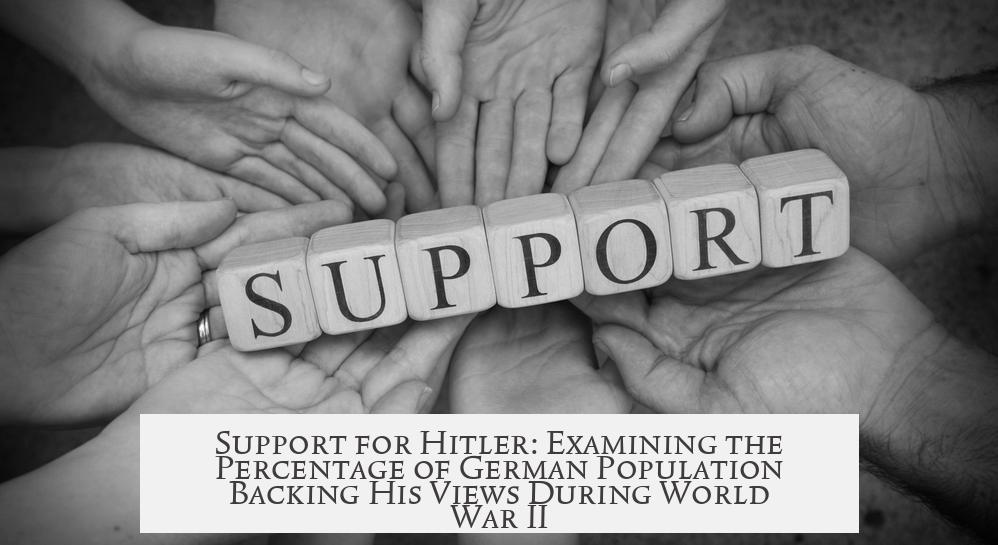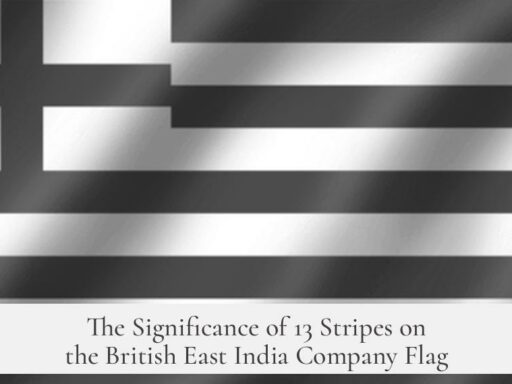Determining the exact percentage of the German population that supported Adolf Hitler and agreed with his views during World War II is challenging due to the absence of reliable, direct polling data from that era and the intimidating political environment discouraging honest expression. However, indirect sources, post-war surveys, and historical analysis provide insights into the levels and fluctuations of this support.
During the Nazi regime, no public opinion polls were conducted that reliably measured support for Hitler or his ideology. Fear of persecution meant that any attempts to assess popular opinion through surveys or informal questioning would likely produce skewed or dishonest answers. Individuals avoided openly expressing dissent due to the totalitarian surveillance and repressive measures in place.
Historians have relied on indirect methods to gauge public sentiment. One primary source is the Meldungen aus dem Reich (Reports from the Reich), secret communications from the Sicherheitsdienst (SD), the SS intelligence service. These reports contained information about rumors, popular attitudes, and general opinion trends conveyed from local agents back to Berlin. They offer qualitative evidence but do not quantify support in percentages.
Personal diaries from the period also shine light on public views. For example, Viktor Klemperer and Friedrich Kellner documented evolving attitudes toward Hitler and the regime. Their writings reveal that support existed but also grew increasingly strained over time as the war progressed and the regime’s brutality became more widely known. Such diaries, however, reflect personal perspectives and are influenced by the authors’ biases and social contexts.
Some historians have examined naming trends as a proxy for popularity. The number of children named “Adolf” rose notably between 1933 and 1941 during Hitler’s ascent, then declined after. This data is intriguing but remains academically controversial since naming conventions involve many social factors unrelated to political allegiance, such as family traditions.
Hitler’s popularity peaked between 1938 and 1941. This period coincides with major territorial expansions, like the annexation of Austria and the Sudetenland, and early military successes which gave him significant support. The aura of the Führer was strongest during these years. However, his popularity declined sharply following major military defeats, notably the Battle of Moscow in late 1941 and the devastating loss at Stalingrad in early 1943. Propaganda efforts by Joseph Goebbels could not entirely mask these failures, which deeply shook public confidence.
Surveys conducted after World War II by the Office of Military Government, United States (OMGUS), provide essential data on German attitudes toward National Socialism shortly after the regime’s end. Between 1945 and 1949, OMGUS carried out 191 public opinion polls in the American occupation zone. Eleven surveys specifically addressed attitudes toward National Socialism, showing that on average, 47% agreed with the statement “National Socialism was a good idea badly carried out.” This suggests that nearly half of respondents viewed the ideology favorably, if not Hitler’s wartime implementation of it.
Further post-war polls reveal complex and disturbing attitudes toward Nazi racial policies. A survey from August 1946 found that 37% agreed the extermination of Jews, Poles, and other “non-Aryan” groups was necessary for Germany’s security. Another 33% believed Jews should not have equal rights. A classification survey in March 1947 divided respondents into ideological groups finding around 40% expressed racist or anti-Semitic beliefs, including intense anti-Semitism. These figures indicate significant portions of the population retained or harbored sympathies with key Nazi doctrines, including racial hatred.
Immediate post-war polls by occupying forces also show that despite the exposure of concentration camps and Holocaust atrocities, about 25-30% of Germans still supported National Socialism as of 1946. This was despite Allied efforts to educate the population about Nazi crimes. The November Pogroms (Kristallnacht in 1938) had not significantly dented Hitler’s popularity at the time, indicating widespread either tacit approval or fear-induced silence among the populace.
| Timeframe | Support Indicators |
|---|---|
| 1938–1941 | Popularity peak due to territorial expansions and early war successes |
| Post-1941 | Decline after military defeats; morale drops |
| 1945–1949 (OMGUS surveys) | ~47% see National Socialism as a good idea poorly implemented; 25–30% support post-war National Socialism; Significant anti-Semitic sentiments persist |
Many historians caution against overgeneralizing these figures. Silent opposition existed, but it was dangerous to express openly. Similarly, support ranged from enthusiastic approval to compliance out of fear or opportunism. Support for Hitler did not necessarily mean approval of every policy, especially genocidal ones. Propaganda influence, social pressures, economic improvements, and nationalist pride all played roles in shaping views.
The question of German support during the Holocaust specifically remains difficult to answer with precision. At least during the early and middle war years, ignorance, propaganda, or denial about the full extent of atrocities may have influenced perceptions. By later war years and post-war surveys, significant portions of the population showed sympathy for Nazi racial ideology, even if they were not fully aware of or did not publicly acknowledge the scope of exterminations.
- No reliable direct polling on Hitler’s support existed during WWII due to repression and fear.
- Intelligence reports and diaries suggest fluctuating support, peaking 1938–1941 and declining after major defeats.
- Post-war US surveys show roughly half felt National Socialism was a good idea poorly executed.
- Between 25-30% supported National Socialism even after the war and exposure of the Holocaust.
- Significant anti-Semitic attitudes persisted post-war, indicating enduring agreement with aspects of Nazi ideology.
What percentage of Germans supported Hitler’s views during World War II?
No exact percentage exists because no honest polls were taken then. Fear of persecution stopped many from sharing true opinions. Estimates rely on indirect sources, not direct data.
How did Hitler’s popularity change throughout the war?
Hitler’s popularity peaked from 1938 to 1941 after early successes. It dropped sharply after defeats at Moscow and Stalingrad, reaching very low levels near the war’s end.
Did many Germans agree with Nazi racial policies during the war?
Surveys post-war showed troubling support: in 1946, 37% agreed extermination of Jews and others was necessary for German security. Around one-third thought Jews should not have equal rights.
What do post-war surveys reveal about support for National Socialism?
Between 1945 and 1946, about 47% of Germans felt National Socialism was a good idea but poorly implemented, showing significant lingering support after the war ended.
Are statistics like naming children “Adolf” reliable indicators of support?
No. Naming trends are influenced by many factors unrelated to politics. Historians generally reject such data as a solid measure of Hitler’s support.




